Consumer Buying Behavior on H&M Online Shopping (Vietnam) Dissertation
VerifiedAdded on 2022/02/19
|34
|7232
|29
Thesis and Dissertation
AI Summary
This dissertation investigates the factors influencing consumer buying behavior on online shopping at H&M in Da Nang, Vietnam. It begins with an introduction outlining the rise of online shopping and the popularity of H&M. The research explores key concepts like online shopping behavior, and empirical studies, and proposes a theoretical framework. The methodology section details the research approach, data collection methods, and analysis techniques. The results section presents descriptive and EFA analysis, along with T-tests and ANOVA. The discussion summarizes findings, discusses implications, limitations, and suggests future research directions. The study aims to understand consumer intentions, identify factors impacting online shopping, and offer solutions to enhance customer engagement and trust. The dissertation includes a literature review, a proposed research model, and appendices containing consent forms, surveys, and SPSS analysis outputs. The research questions address factors influencing online shopping behavior, strategies to attract customers, and building customer trust and loyalty. The study also includes a detailed analysis of the factors that influence consumers' purchasing intentions at H&M, offering businesses insights to develop policies and address gaps.
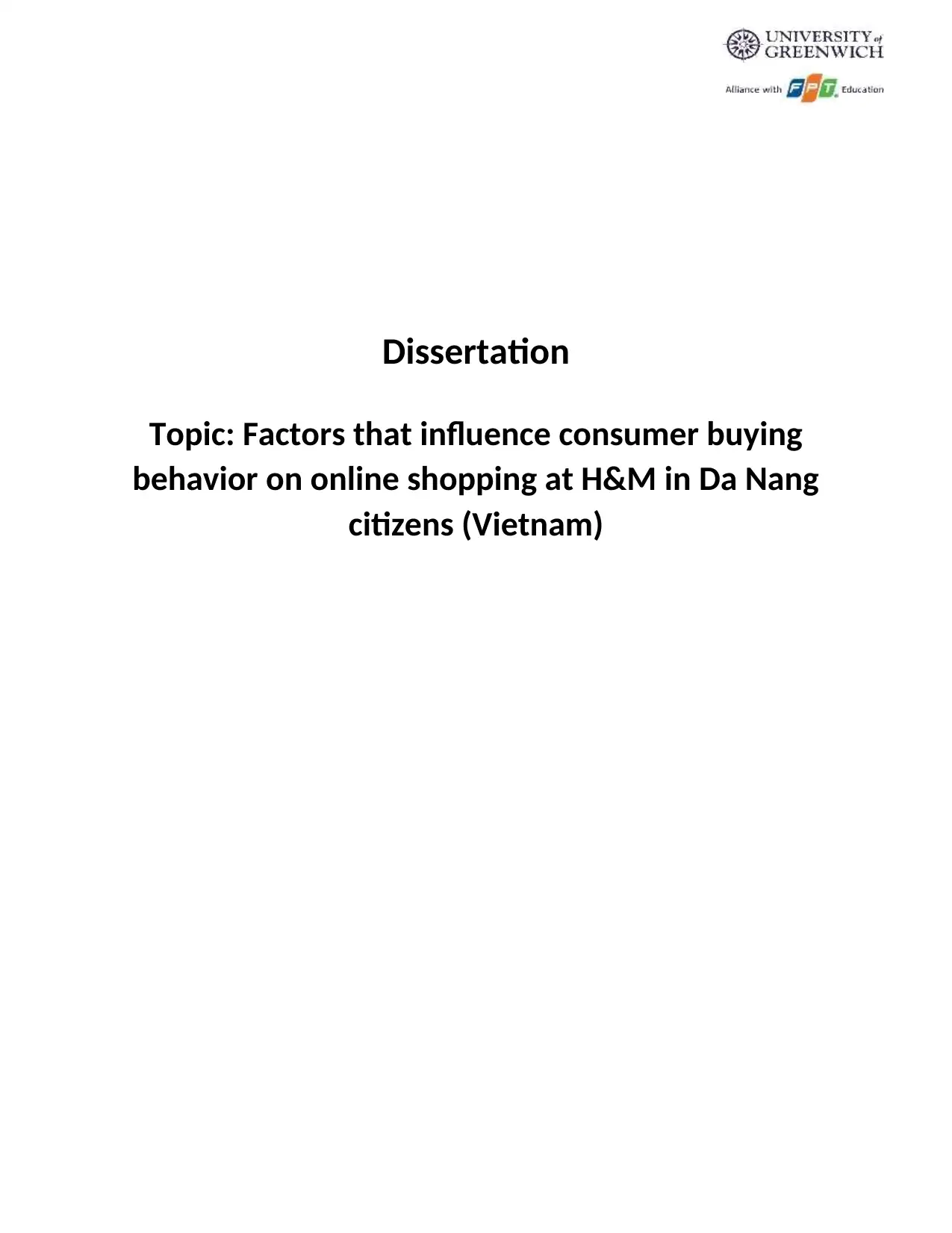
Dissertation
Topic: Factors that influence consumer buying
behavior on online shopping at H&M in Da Nang
citizens (Vietnam)
Topic: Factors that influence consumer buying
behavior on online shopping at H&M in Da Nang
citizens (Vietnam)
Paraphrase This Document
Need a fresh take? Get an instant paraphrase of this document with our AI Paraphraser
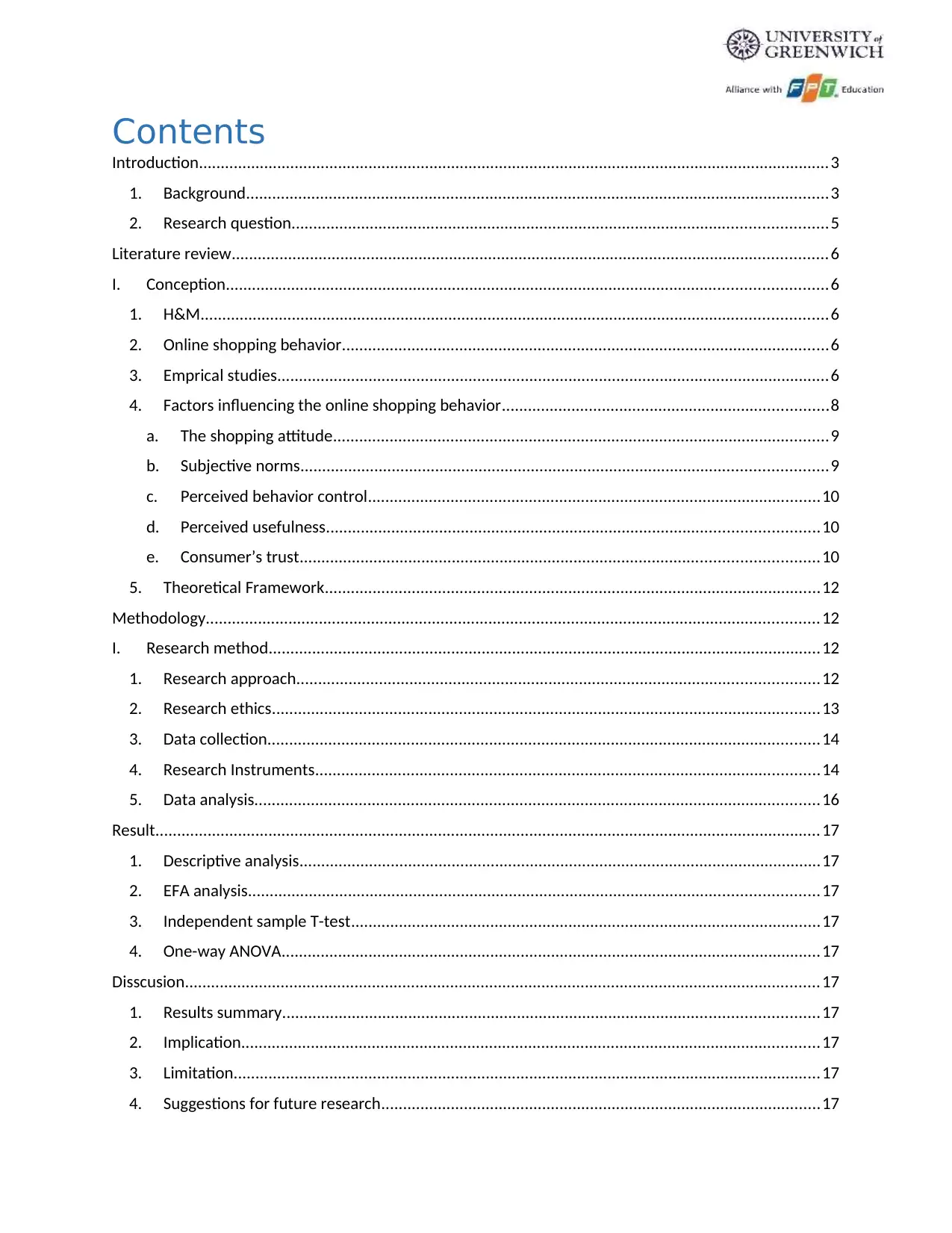
Contents
Introduction.................................................................................................................................................3
1. Background......................................................................................................................................3
2. Research question...........................................................................................................................5
Literature review.........................................................................................................................................6
I. Conception..........................................................................................................................................6
1. H&M................................................................................................................................................6
2. Online shopping behavior................................................................................................................6
3. Emprical studies...............................................................................................................................6
4. Factors influencing the online shopping behavior...........................................................................8
a. The shopping attitude..................................................................................................................9
b. Subjective norms.........................................................................................................................9
c. Perceived behavior control........................................................................................................10
d. Perceived usefulness.................................................................................................................10
e. Consumer’s trust.......................................................................................................................10
5. Theoretical Framework..................................................................................................................12
Methodology.............................................................................................................................................12
I. Research method...............................................................................................................................12
1. Research approach........................................................................................................................12
2. Research ethics..............................................................................................................................13
3. Data collection...............................................................................................................................14
4. Research Instruments....................................................................................................................14
5. Data analysis..................................................................................................................................16
Result.........................................................................................................................................................17
1. Descriptive analysis........................................................................................................................17
2. EFA analysis...................................................................................................................................17
3. Independent sample T-test............................................................................................................17
4. One-way ANOVA............................................................................................................................17
Disscusion..................................................................................................................................................17
1. Results summary...........................................................................................................................17
2. Implication.....................................................................................................................................17
3. Limitation.......................................................................................................................................17
4. Suggestions for future research.....................................................................................................17
Introduction.................................................................................................................................................3
1. Background......................................................................................................................................3
2. Research question...........................................................................................................................5
Literature review.........................................................................................................................................6
I. Conception..........................................................................................................................................6
1. H&M................................................................................................................................................6
2. Online shopping behavior................................................................................................................6
3. Emprical studies...............................................................................................................................6
4. Factors influencing the online shopping behavior...........................................................................8
a. The shopping attitude..................................................................................................................9
b. Subjective norms.........................................................................................................................9
c. Perceived behavior control........................................................................................................10
d. Perceived usefulness.................................................................................................................10
e. Consumer’s trust.......................................................................................................................10
5. Theoretical Framework..................................................................................................................12
Methodology.............................................................................................................................................12
I. Research method...............................................................................................................................12
1. Research approach........................................................................................................................12
2. Research ethics..............................................................................................................................13
3. Data collection...............................................................................................................................14
4. Research Instruments....................................................................................................................14
5. Data analysis..................................................................................................................................16
Result.........................................................................................................................................................17
1. Descriptive analysis........................................................................................................................17
2. EFA analysis...................................................................................................................................17
3. Independent sample T-test............................................................................................................17
4. One-way ANOVA............................................................................................................................17
Disscusion..................................................................................................................................................17
1. Results summary...........................................................................................................................17
2. Implication.....................................................................................................................................17
3. Limitation.......................................................................................................................................17
4. Suggestions for future research.....................................................................................................17
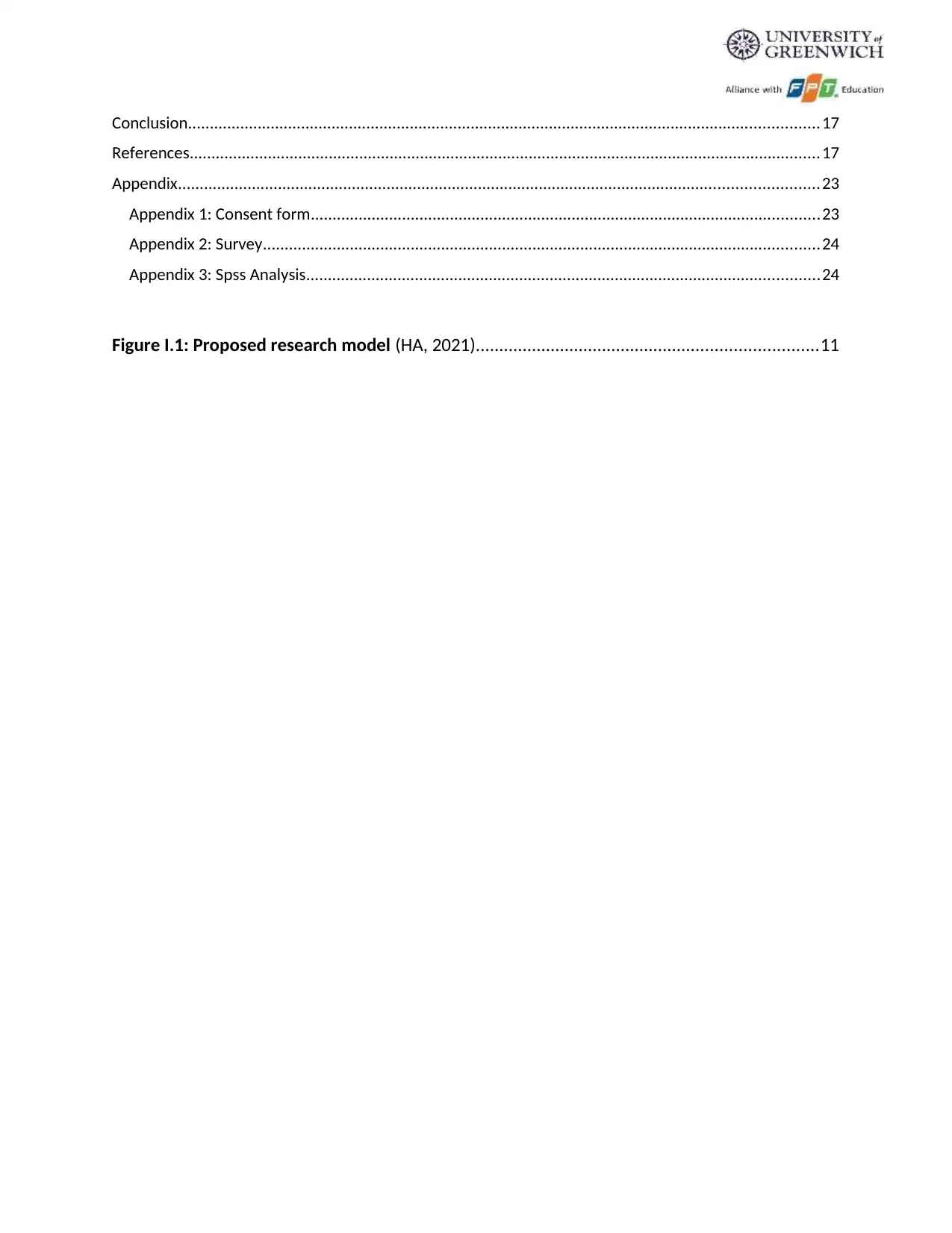
Conclusion.................................................................................................................................................17
References.................................................................................................................................................17
Appendix...................................................................................................................................................23
Appendix 1: Consent form.....................................................................................................................23
Appendix 2: Survey................................................................................................................................24
Appendix 3: Spss Analysis......................................................................................................................24
Figure I.1: Proposed research model (HA, 2021).........................................................................11
References.................................................................................................................................................17
Appendix...................................................................................................................................................23
Appendix 1: Consent form.....................................................................................................................23
Appendix 2: Survey................................................................................................................................24
Appendix 3: Spss Analysis......................................................................................................................24
Figure I.1: Proposed research model (HA, 2021).........................................................................11
⊘ This is a preview!⊘
Do you want full access?
Subscribe today to unlock all pages.

Trusted by 1+ million students worldwide
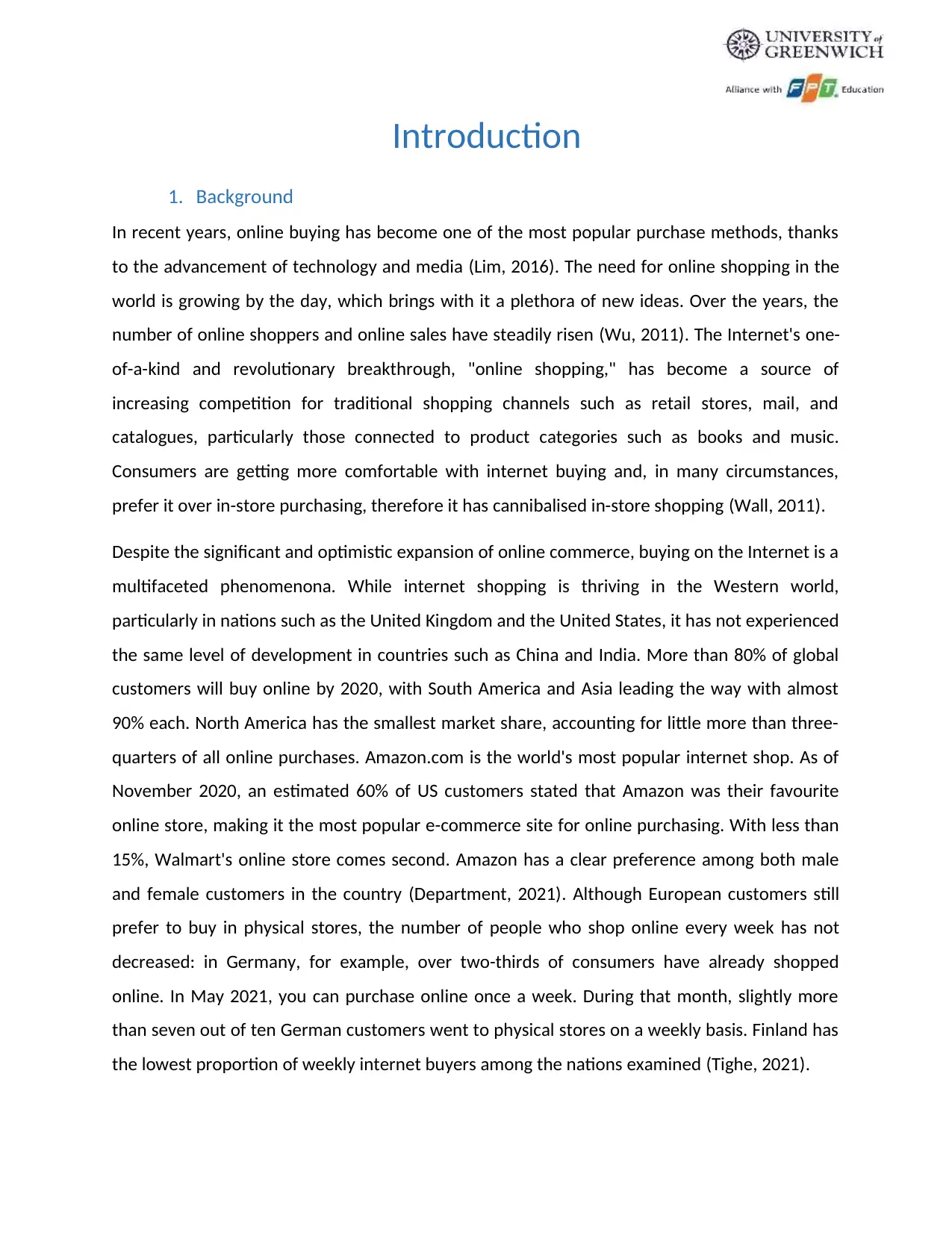
Introduction
1. Background
In recent years, online buying has become one of the most popular purchase methods, thanks
to the advancement of technology and media (Lim, 2016). The need for online shopping in the
world is growing by the day, which brings with it a plethora of new ideas. Over the years, the
number of online shoppers and online sales have steadily risen (Wu, 2011). The Internet's one-
of-a-kind and revolutionary breakthrough, "online shopping," has become a source of
increasing competition for traditional shopping channels such as retail stores, mail, and
catalogues, particularly those connected to product categories such as books and music.
Consumers are getting more comfortable with internet buying and, in many circumstances,
prefer it over in-store purchasing, therefore it has cannibalised in-store shopping (Wall, 2011).
Despite the significant and optimistic expansion of online commerce, buying on the Internet is a
multifaceted phenomenona. While internet shopping is thriving in the Western world,
particularly in nations such as the United Kingdom and the United States, it has not experienced
the same level of development in countries such as China and India. More than 80% of global
customers will buy online by 2020, with South America and Asia leading the way with almost
90% each. North America has the smallest market share, accounting for little more than three-
quarters of all online purchases. Amazon.com is the world's most popular internet shop. As of
November 2020, an estimated 60% of US customers stated that Amazon was their favourite
online store, making it the most popular e-commerce site for online purchasing. With less than
15%, Walmart's online store comes second. Amazon has a clear preference among both male
and female customers in the country (Department, 2021). Although European customers still
prefer to buy in physical stores, the number of people who shop online every week has not
decreased: in Germany, for example, over two-thirds of consumers have already shopped
online. In May 2021, you can purchase online once a week. During that month, slightly more
than seven out of ten German customers went to physical stores on a weekly basis. Finland has
the lowest proportion of weekly internet buyers among the nations examined (Tighe, 2021).
1. Background
In recent years, online buying has become one of the most popular purchase methods, thanks
to the advancement of technology and media (Lim, 2016). The need for online shopping in the
world is growing by the day, which brings with it a plethora of new ideas. Over the years, the
number of online shoppers and online sales have steadily risen (Wu, 2011). The Internet's one-
of-a-kind and revolutionary breakthrough, "online shopping," has become a source of
increasing competition for traditional shopping channels such as retail stores, mail, and
catalogues, particularly those connected to product categories such as books and music.
Consumers are getting more comfortable with internet buying and, in many circumstances,
prefer it over in-store purchasing, therefore it has cannibalised in-store shopping (Wall, 2011).
Despite the significant and optimistic expansion of online commerce, buying on the Internet is a
multifaceted phenomenona. While internet shopping is thriving in the Western world,
particularly in nations such as the United Kingdom and the United States, it has not experienced
the same level of development in countries such as China and India. More than 80% of global
customers will buy online by 2020, with South America and Asia leading the way with almost
90% each. North America has the smallest market share, accounting for little more than three-
quarters of all online purchases. Amazon.com is the world's most popular internet shop. As of
November 2020, an estimated 60% of US customers stated that Amazon was their favourite
online store, making it the most popular e-commerce site for online purchasing. With less than
15%, Walmart's online store comes second. Amazon has a clear preference among both male
and female customers in the country (Department, 2021). Although European customers still
prefer to buy in physical stores, the number of people who shop online every week has not
decreased: in Germany, for example, over two-thirds of consumers have already shopped
online. In May 2021, you can purchase online once a week. During that month, slightly more
than seven out of ten German customers went to physical stores on a weekly basis. Finland has
the lowest proportion of weekly internet buyers among the nations examined (Tighe, 2021).
Paraphrase This Document
Need a fresh take? Get an instant paraphrase of this document with our AI Paraphraser
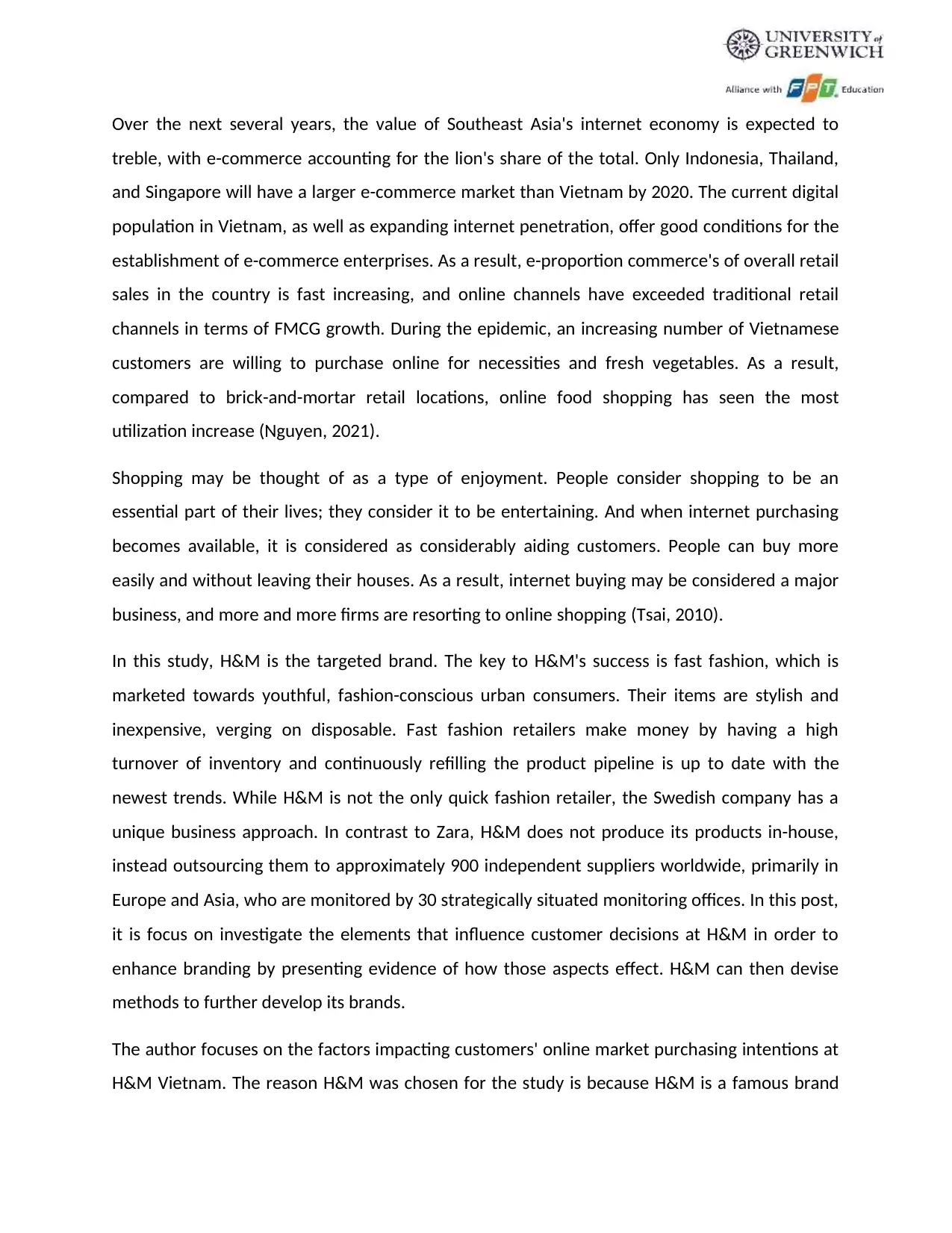
Over the next several years, the value of Southeast Asia's internet economy is expected to
treble, with e-commerce accounting for the lion's share of the total. Only Indonesia, Thailand,
and Singapore will have a larger e-commerce market than Vietnam by 2020. The current digital
population in Vietnam, as well as expanding internet penetration, offer good conditions for the
establishment of e-commerce enterprises. As a result, e-proportion commerce's of overall retail
sales in the country is fast increasing, and online channels have exceeded traditional retail
channels in terms of FMCG growth. During the epidemic, an increasing number of Vietnamese
customers are willing to purchase online for necessities and fresh vegetables. As a result,
compared to brick-and-mortar retail locations, online food shopping has seen the most
utilization increase (Nguyen, 2021).
Shopping may be thought of as a type of enjoyment. People consider shopping to be an
essential part of their lives; they consider it to be entertaining. And when internet purchasing
becomes available, it is considered as considerably aiding customers. People can buy more
easily and without leaving their houses. As a result, internet buying may be considered a major
business, and more and more firms are resorting to online shopping (Tsai, 2010).
In this study, H&M is the targeted brand. The key to H&M's success is fast fashion, which is
marketed towards youthful, fashion-conscious urban consumers. Their items are stylish and
inexpensive, verging on disposable. Fast fashion retailers make money by having a high
turnover of inventory and continuously refilling the product pipeline is up to date with the
newest trends. While H&M is not the only quick fashion retailer, the Swedish company has a
unique business approach. In contrast to Zara, H&M does not produce its products in-house,
instead outsourcing them to approximately 900 independent suppliers worldwide, primarily in
Europe and Asia, who are monitored by 30 strategically situated monitoring offices. In this post,
it is focus on investigate the elements that influence customer decisions at H&M in order to
enhance branding by presenting evidence of how those aspects effect. H&M can then devise
methods to further develop its brands.
The author focuses on the factors impacting customers' online market purchasing intentions at
H&M Vietnam. The reason H&M was chosen for the study is because H&M is a famous brand
treble, with e-commerce accounting for the lion's share of the total. Only Indonesia, Thailand,
and Singapore will have a larger e-commerce market than Vietnam by 2020. The current digital
population in Vietnam, as well as expanding internet penetration, offer good conditions for the
establishment of e-commerce enterprises. As a result, e-proportion commerce's of overall retail
sales in the country is fast increasing, and online channels have exceeded traditional retail
channels in terms of FMCG growth. During the epidemic, an increasing number of Vietnamese
customers are willing to purchase online for necessities and fresh vegetables. As a result,
compared to brick-and-mortar retail locations, online food shopping has seen the most
utilization increase (Nguyen, 2021).
Shopping may be thought of as a type of enjoyment. People consider shopping to be an
essential part of their lives; they consider it to be entertaining. And when internet purchasing
becomes available, it is considered as considerably aiding customers. People can buy more
easily and without leaving their houses. As a result, internet buying may be considered a major
business, and more and more firms are resorting to online shopping (Tsai, 2010).
In this study, H&M is the targeted brand. The key to H&M's success is fast fashion, which is
marketed towards youthful, fashion-conscious urban consumers. Their items are stylish and
inexpensive, verging on disposable. Fast fashion retailers make money by having a high
turnover of inventory and continuously refilling the product pipeline is up to date with the
newest trends. While H&M is not the only quick fashion retailer, the Swedish company has a
unique business approach. In contrast to Zara, H&M does not produce its products in-house,
instead outsourcing them to approximately 900 independent suppliers worldwide, primarily in
Europe and Asia, who are monitored by 30 strategically situated monitoring offices. In this post,
it is focus on investigate the elements that influence customer decisions at H&M in order to
enhance branding by presenting evidence of how those aspects effect. H&M can then devise
methods to further develop its brands.
The author focuses on the factors impacting customers' online market purchasing intentions at
H&M Vietnam. The reason H&M was chosen for the study is because H&M is a famous brand
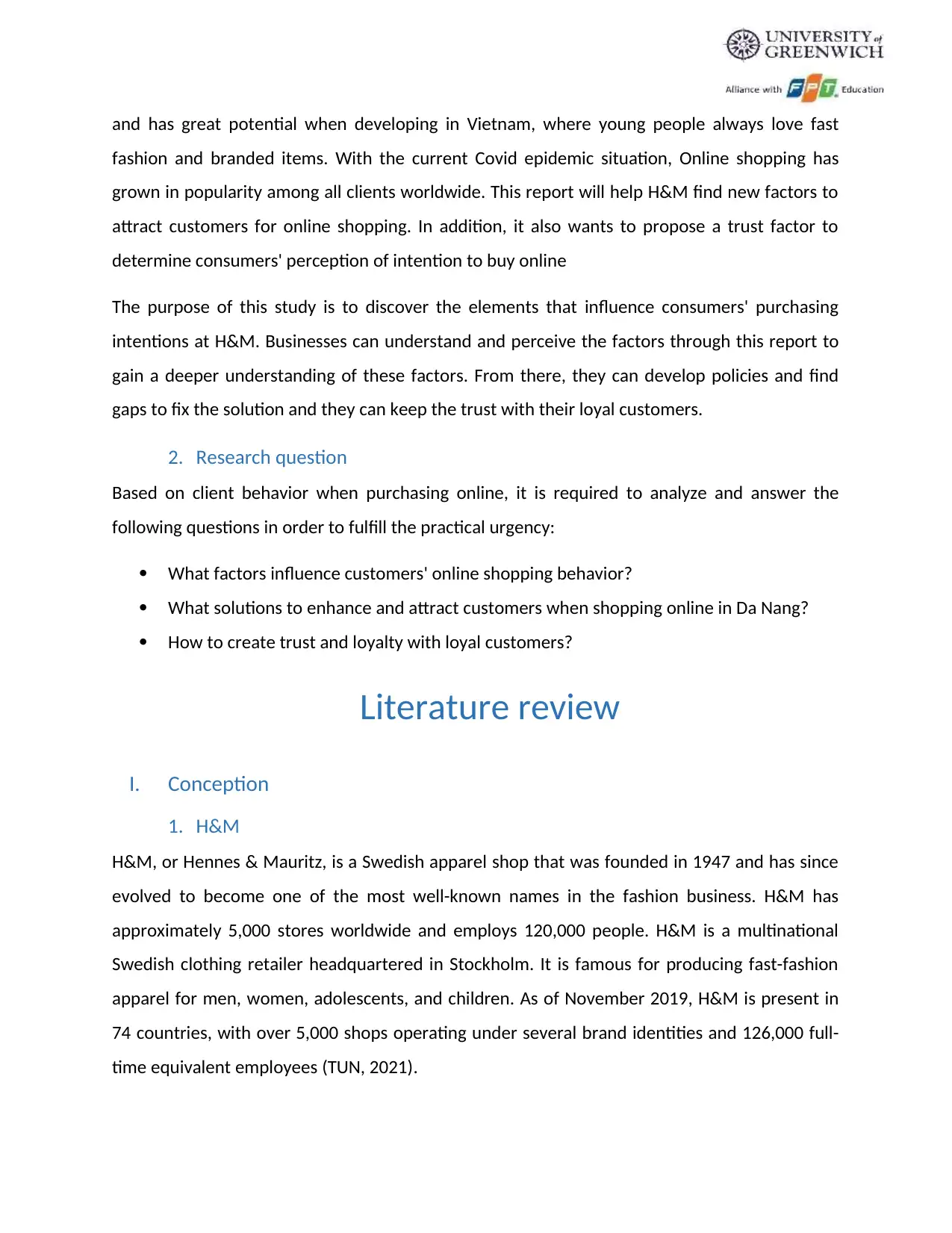
and has great potential when developing in Vietnam, where young people always love fast
fashion and branded items. With the current Covid epidemic situation, Online shopping has
grown in popularity among all clients worldwide. This report will help H&M find new factors to
attract customers for online shopping. In addition, it also wants to propose a trust factor to
determine consumers' perception of intention to buy online
The purpose of this study is to discover the elements that influence consumers' purchasing
intentions at H&M. Businesses can understand and perceive the factors through this report to
gain a deeper understanding of these factors. From there, they can develop policies and find
gaps to fix the solution and they can keep the trust with their loyal customers.
2. Research question
Based on client behavior when purchasing online, it is required to analyze and answer the
following questions in order to fulfill the practical urgency:
What factors influence customers' online shopping behavior?
What solutions to enhance and attract customers when shopping online in Da Nang?
How to create trust and loyalty with loyal customers?
Literature review
I. Conception
1. H&M
H&M, or Hennes & Mauritz, is a Swedish apparel shop that was founded in 1947 and has since
evolved to become one of the most well-known names in the fashion business. H&M has
approximately 5,000 stores worldwide and employs 120,000 people. H&M is a multinational
Swedish clothing retailer headquartered in Stockholm. It is famous for producing fast-fashion
apparel for men, women, adolescents, and children. As of November 2019, H&M is present in
74 countries, with over 5,000 shops operating under several brand identities and 126,000 full-
time equivalent employees (TUN, 2021).
fashion and branded items. With the current Covid epidemic situation, Online shopping has
grown in popularity among all clients worldwide. This report will help H&M find new factors to
attract customers for online shopping. In addition, it also wants to propose a trust factor to
determine consumers' perception of intention to buy online
The purpose of this study is to discover the elements that influence consumers' purchasing
intentions at H&M. Businesses can understand and perceive the factors through this report to
gain a deeper understanding of these factors. From there, they can develop policies and find
gaps to fix the solution and they can keep the trust with their loyal customers.
2. Research question
Based on client behavior when purchasing online, it is required to analyze and answer the
following questions in order to fulfill the practical urgency:
What factors influence customers' online shopping behavior?
What solutions to enhance and attract customers when shopping online in Da Nang?
How to create trust and loyalty with loyal customers?
Literature review
I. Conception
1. H&M
H&M, or Hennes & Mauritz, is a Swedish apparel shop that was founded in 1947 and has since
evolved to become one of the most well-known names in the fashion business. H&M has
approximately 5,000 stores worldwide and employs 120,000 people. H&M is a multinational
Swedish clothing retailer headquartered in Stockholm. It is famous for producing fast-fashion
apparel for men, women, adolescents, and children. As of November 2019, H&M is present in
74 countries, with over 5,000 shops operating under several brand identities and 126,000 full-
time equivalent employees (TUN, 2021).
⊘ This is a preview!⊘
Do you want full access?
Subscribe today to unlock all pages.

Trusted by 1+ million students worldwide
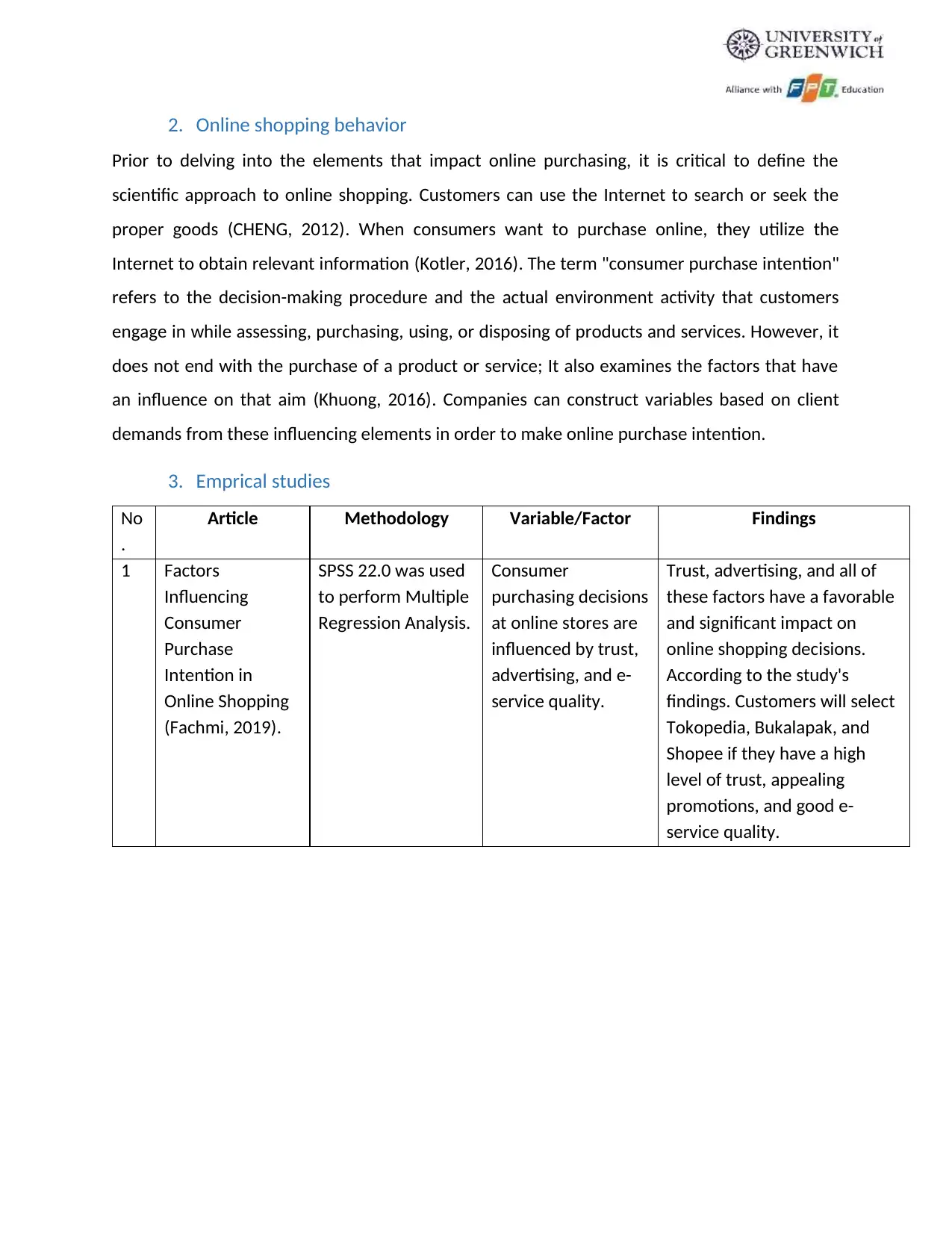
2. Online shopping behavior
Prior to delving into the elements that impact online purchasing, it is critical to define the
scientific approach to online shopping. Customers can use the Internet to search or seek the
proper goods (CHENG, 2012). When consumers want to purchase online, they utilize the
Internet to obtain relevant information (Kotler, 2016). The term "consumer purchase intention"
refers to the decision-making procedure and the actual environment activity that customers
engage in while assessing, purchasing, using, or disposing of products and services. However, it
does not end with the purchase of a product or service; It also examines the factors that have
an influence on that aim (Khuong, 2016). Companies can construct variables based on client
demands from these influencing elements in order to make online purchase intention.
3. Emprical studies
No
.
Article Methodology Variable/Factor Findings
1 Factors
Influencing
Consumer
Purchase
Intention in
Online Shopping
(Fachmi, 2019).
SPSS 22.0 was used
to perform Multiple
Regression Analysis.
Consumer
purchasing decisions
at online stores are
influenced by trust,
advertising, and e-
service quality.
Trust, advertising, and all of
these factors have a favorable
and significant impact on
online shopping decisions.
According to the study's
findings. Customers will select
Tokopedia, Bukalapak, and
Shopee if they have a high
level of trust, appealing
promotions, and good e-
service quality.
Prior to delving into the elements that impact online purchasing, it is critical to define the
scientific approach to online shopping. Customers can use the Internet to search or seek the
proper goods (CHENG, 2012). When consumers want to purchase online, they utilize the
Internet to obtain relevant information (Kotler, 2016). The term "consumer purchase intention"
refers to the decision-making procedure and the actual environment activity that customers
engage in while assessing, purchasing, using, or disposing of products and services. However, it
does not end with the purchase of a product or service; It also examines the factors that have
an influence on that aim (Khuong, 2016). Companies can construct variables based on client
demands from these influencing elements in order to make online purchase intention.
3. Emprical studies
No
.
Article Methodology Variable/Factor Findings
1 Factors
Influencing
Consumer
Purchase
Intention in
Online Shopping
(Fachmi, 2019).
SPSS 22.0 was used
to perform Multiple
Regression Analysis.
Consumer
purchasing decisions
at online stores are
influenced by trust,
advertising, and e-
service quality.
Trust, advertising, and all of
these factors have a favorable
and significant impact on
online shopping decisions.
According to the study's
findings. Customers will select
Tokopedia, Bukalapak, and
Shopee if they have a high
level of trust, appealing
promotions, and good e-
service quality.
Paraphrase This Document
Need a fresh take? Get an instant paraphrase of this document with our AI Paraphraser
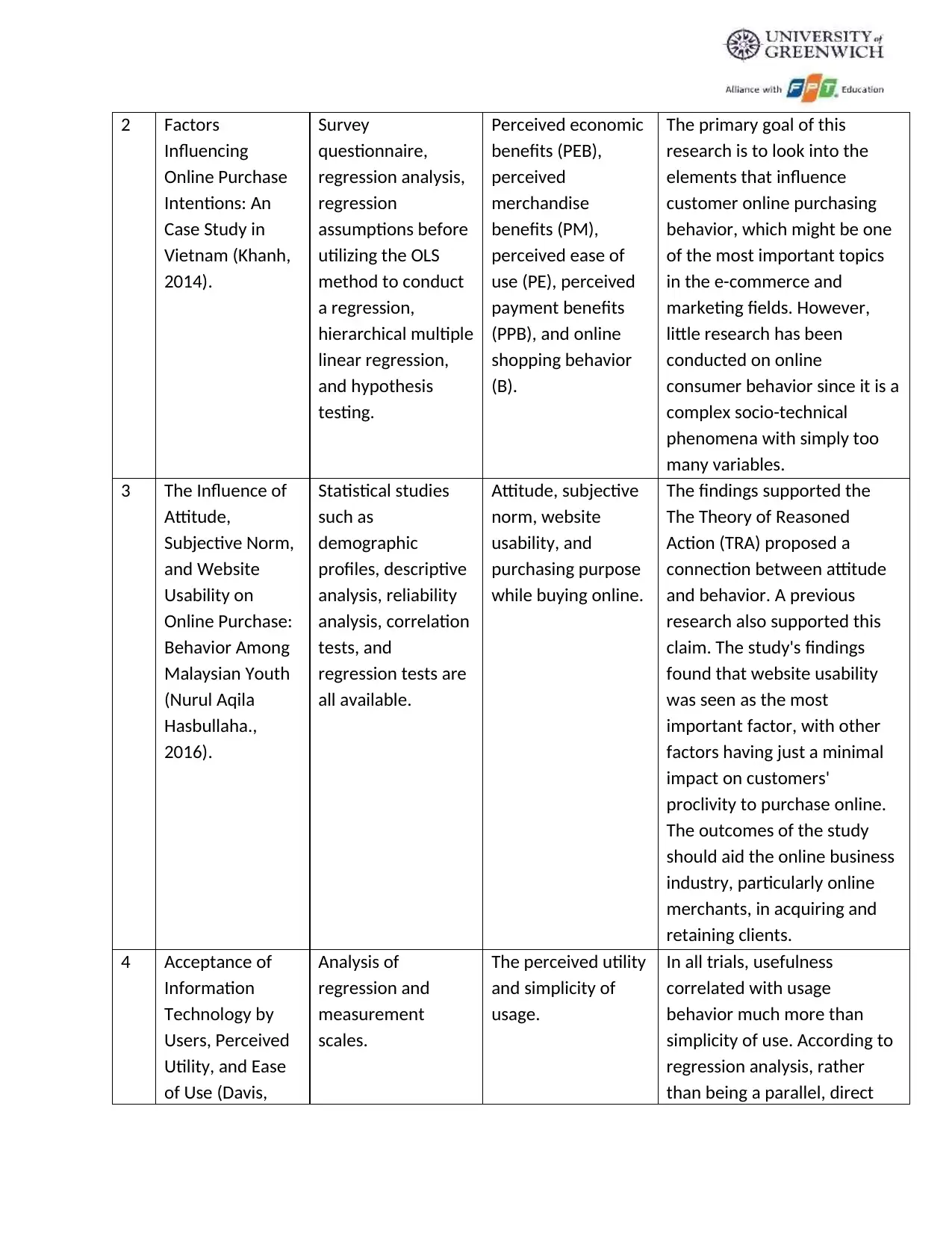
2 Factors
Influencing
Online Purchase
Intentions: An
Case Study in
Vietnam (Khanh,
2014).
Survey
questionnaire,
regression analysis,
regression
assumptions before
utilizing the OLS
method to conduct
a regression,
hierarchical multiple
linear regression,
and hypothesis
testing.
Perceived economic
benefits (PEB),
perceived
merchandise
benefits (PM),
perceived ease of
use (PE), perceived
payment benefits
(PPB), and online
shopping behavior
(B).
The primary goal of this
research is to look into the
elements that influence
customer online purchasing
behavior, which might be one
of the most important topics
in the e-commerce and
marketing fields. However,
little research has been
conducted on online
consumer behavior since it is a
complex socio-technical
phenomena with simply too
many variables.
3 The Influence of
Attitude,
Subjective Norm,
and Website
Usability on
Online Purchase:
Behavior Among
Malaysian Youth
(Nurul Aqila
Hasbullaha.,
2016).
Statistical studies
such as
demographic
profiles, descriptive
analysis, reliability
analysis, correlation
tests, and
regression tests are
all available.
Attitude, subjective
norm, website
usability, and
purchasing purpose
while buying online.
The findings supported the
The Theory of Reasoned
Action (TRA) proposed a
connection between attitude
and behavior. A previous
research also supported this
claim. The study's findings
found that website usability
was seen as the most
important factor, with other
factors having just a minimal
impact on customers'
proclivity to purchase online.
The outcomes of the study
should aid the online business
industry, particularly online
merchants, in acquiring and
retaining clients.
4 Acceptance of
Information
Technology by
Users, Perceived
Utility, and Ease
of Use (Davis,
Analysis of
regression and
measurement
scales.
The perceived utility
and simplicity of
usage.
In all trials, usefulness
correlated with usage
behavior much more than
simplicity of use. According to
regression analysis, rather
than being a parallel, direct
Influencing
Online Purchase
Intentions: An
Case Study in
Vietnam (Khanh,
2014).
Survey
questionnaire,
regression analysis,
regression
assumptions before
utilizing the OLS
method to conduct
a regression,
hierarchical multiple
linear regression,
and hypothesis
testing.
Perceived economic
benefits (PEB),
perceived
merchandise
benefits (PM),
perceived ease of
use (PE), perceived
payment benefits
(PPB), and online
shopping behavior
(B).
The primary goal of this
research is to look into the
elements that influence
customer online purchasing
behavior, which might be one
of the most important topics
in the e-commerce and
marketing fields. However,
little research has been
conducted on online
consumer behavior since it is a
complex socio-technical
phenomena with simply too
many variables.
3 The Influence of
Attitude,
Subjective Norm,
and Website
Usability on
Online Purchase:
Behavior Among
Malaysian Youth
(Nurul Aqila
Hasbullaha.,
2016).
Statistical studies
such as
demographic
profiles, descriptive
analysis, reliability
analysis, correlation
tests, and
regression tests are
all available.
Attitude, subjective
norm, website
usability, and
purchasing purpose
while buying online.
The findings supported the
The Theory of Reasoned
Action (TRA) proposed a
connection between attitude
and behavior. A previous
research also supported this
claim. The study's findings
found that website usability
was seen as the most
important factor, with other
factors having just a minimal
impact on customers'
proclivity to purchase online.
The outcomes of the study
should aid the online business
industry, particularly online
merchants, in acquiring and
retaining clients.
4 Acceptance of
Information
Technology by
Users, Perceived
Utility, and Ease
of Use (Davis,
Analysis of
regression and
measurement
scales.
The perceived utility
and simplicity of
usage.
In all trials, usefulness
correlated with usage
behavior much more than
simplicity of use. According to
regression analysis, rather
than being a parallel, direct
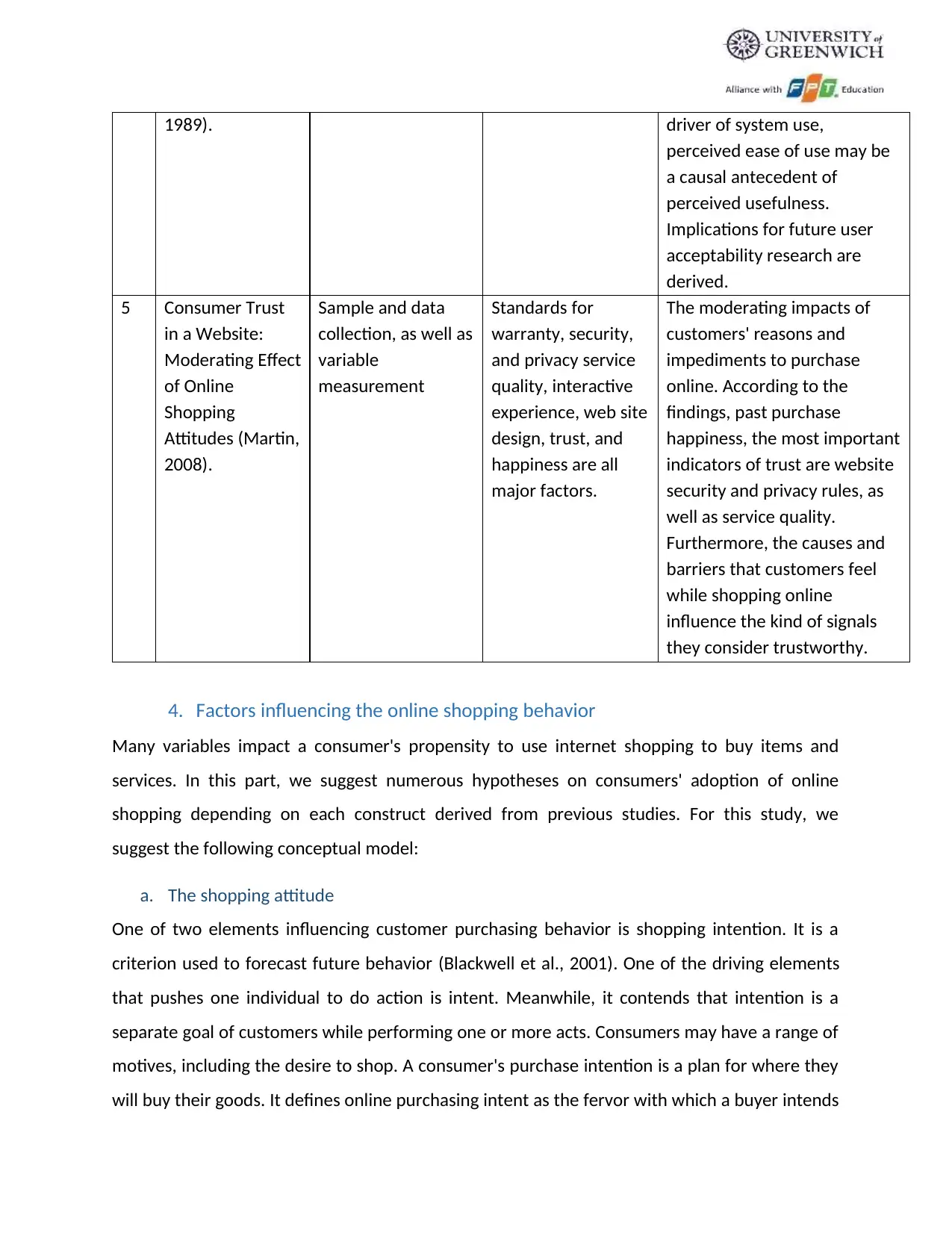
1989). driver of system use,
perceived ease of use may be
a causal antecedent of
perceived usefulness.
Implications for future user
acceptability research are
derived.
5 Consumer Trust
in a Website:
Moderating Effect
of Online
Shopping
Attitudes (Martin,
2008).
Sample and data
collection, as well as
variable
measurement
Standards for
warranty, security,
and privacy service
quality, interactive
experience, web site
design, trust, and
happiness are all
major factors.
The moderating impacts of
customers' reasons and
impediments to purchase
online. According to the
findings, past purchase
happiness, the most important
indicators of trust are website
security and privacy rules, as
well as service quality.
Furthermore, the causes and
barriers that customers feel
while shopping online
influence the kind of signals
they consider trustworthy.
4. Factors influencing the online shopping behavior
Many variables impact a consumer's propensity to use internet shopping to buy items and
services. In this part, we suggest numerous hypotheses on consumers' adoption of online
shopping depending on each construct derived from previous studies. For this study, we
suggest the following conceptual model:
a. The shopping attitude
One of two elements influencing customer purchasing behavior is shopping intention. It is a
criterion used to forecast future behavior (Blackwell et al., 2001). One of the driving elements
that pushes one individual to do action is intent. Meanwhile, it contends that intention is a
separate goal of customers while performing one or more acts. Consumers may have a range of
motives, including the desire to shop. A consumer's purchase intention is a plan for where they
will buy their goods. It defines online purchasing intent as the fervor with which a buyer intends
perceived ease of use may be
a causal antecedent of
perceived usefulness.
Implications for future user
acceptability research are
derived.
5 Consumer Trust
in a Website:
Moderating Effect
of Online
Shopping
Attitudes (Martin,
2008).
Sample and data
collection, as well as
variable
measurement
Standards for
warranty, security,
and privacy service
quality, interactive
experience, web site
design, trust, and
happiness are all
major factors.
The moderating impacts of
customers' reasons and
impediments to purchase
online. According to the
findings, past purchase
happiness, the most important
indicators of trust are website
security and privacy rules, as
well as service quality.
Furthermore, the causes and
barriers that customers feel
while shopping online
influence the kind of signals
they consider trustworthy.
4. Factors influencing the online shopping behavior
Many variables impact a consumer's propensity to use internet shopping to buy items and
services. In this part, we suggest numerous hypotheses on consumers' adoption of online
shopping depending on each construct derived from previous studies. For this study, we
suggest the following conceptual model:
a. The shopping attitude
One of two elements influencing customer purchasing behavior is shopping intention. It is a
criterion used to forecast future behavior (Blackwell et al., 2001). One of the driving elements
that pushes one individual to do action is intent. Meanwhile, it contends that intention is a
separate goal of customers while performing one or more acts. Consumers may have a range of
motives, including the desire to shop. A consumer's purchase intention is a plan for where they
will buy their goods. It defines online purchasing intent as the fervor with which a buyer intends
⊘ This is a preview!⊘
Do you want full access?
Subscribe today to unlock all pages.

Trusted by 1+ million students worldwide
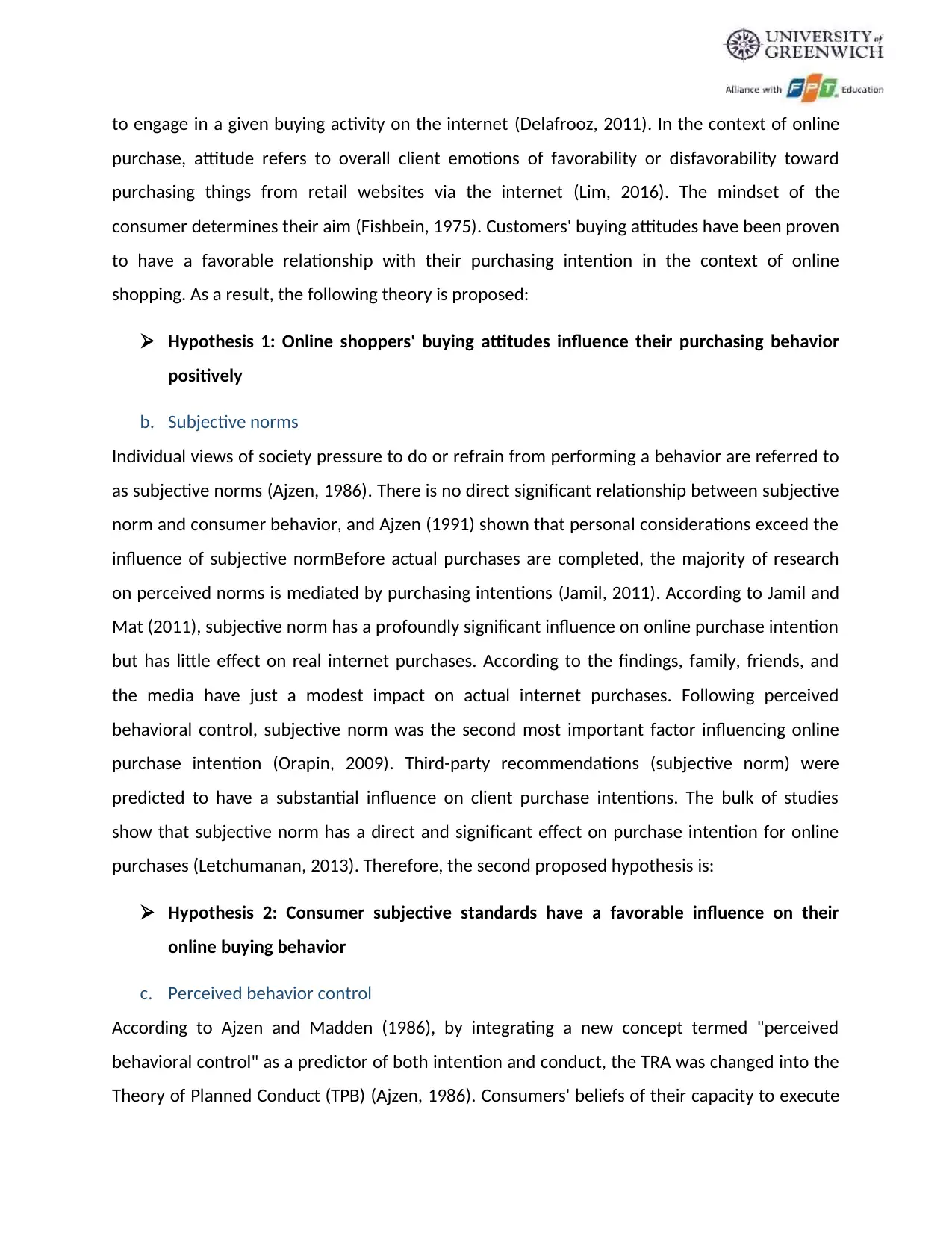
to engage in a given buying activity on the internet (Delafrooz, 2011). In the context of online
purchase, attitude refers to overall client emotions of favorability or disfavorability toward
purchasing things from retail websites via the internet (Lim, 2016). The mindset of the
consumer determines their aim (Fishbein, 1975). Customers' buying attitudes have been proven
to have a favorable relationship with their purchasing intention in the context of online
shopping. As a result, the following theory is proposed:
Hypothesis 1: Online shoppers' buying attitudes influence their purchasing behavior
positively
b. Subjective norms
Individual views of society pressure to do or refrain from performing a behavior are referred to
as subjective norms (Ajzen, 1986). There is no direct significant relationship between subjective
norm and consumer behavior, and Ajzen (1991) shown that personal considerations exceed the
influence of subjective normBefore actual purchases are completed, the majority of research
on perceived norms is mediated by purchasing intentions (Jamil, 2011). According to Jamil and
Mat (2011), subjective norm has a profoundly significant influence on online purchase intention
but has little effect on real internet purchases. According to the findings, family, friends, and
the media have just a modest impact on actual internet purchases. Following perceived
behavioral control, subjective norm was the second most important factor influencing online
purchase intention (Orapin, 2009). Third-party recommendations (subjective norm) were
predicted to have a substantial influence on client purchase intentions. The bulk of studies
show that subjective norm has a direct and significant effect on purchase intention for online
purchases (Letchumanan, 2013). Therefore, the second proposed hypothesis is:
Hypothesis 2: Consumer subjective standards have a favorable influence on their
online buying behavior
c. Perceived behavior control
According to Ajzen and Madden (1986), by integrating a new concept termed "perceived
behavioral control" as a predictor of both intention and conduct, the TRA was changed into the
Theory of Planned Conduct (TPB) (Ajzen, 1986). Consumers' beliefs of their capacity to execute
purchase, attitude refers to overall client emotions of favorability or disfavorability toward
purchasing things from retail websites via the internet (Lim, 2016). The mindset of the
consumer determines their aim (Fishbein, 1975). Customers' buying attitudes have been proven
to have a favorable relationship with their purchasing intention in the context of online
shopping. As a result, the following theory is proposed:
Hypothesis 1: Online shoppers' buying attitudes influence their purchasing behavior
positively
b. Subjective norms
Individual views of society pressure to do or refrain from performing a behavior are referred to
as subjective norms (Ajzen, 1986). There is no direct significant relationship between subjective
norm and consumer behavior, and Ajzen (1991) shown that personal considerations exceed the
influence of subjective normBefore actual purchases are completed, the majority of research
on perceived norms is mediated by purchasing intentions (Jamil, 2011). According to Jamil and
Mat (2011), subjective norm has a profoundly significant influence on online purchase intention
but has little effect on real internet purchases. According to the findings, family, friends, and
the media have just a modest impact on actual internet purchases. Following perceived
behavioral control, subjective norm was the second most important factor influencing online
purchase intention (Orapin, 2009). Third-party recommendations (subjective norm) were
predicted to have a substantial influence on client purchase intentions. The bulk of studies
show that subjective norm has a direct and significant effect on purchase intention for online
purchases (Letchumanan, 2013). Therefore, the second proposed hypothesis is:
Hypothesis 2: Consumer subjective standards have a favorable influence on their
online buying behavior
c. Perceived behavior control
According to Ajzen and Madden (1986), by integrating a new concept termed "perceived
behavioral control" as a predictor of both intention and conduct, the TRA was changed into the
Theory of Planned Conduct (TPB) (Ajzen, 1986). Consumers' beliefs of their capacity to execute
Paraphrase This Document
Need a fresh take? Get an instant paraphrase of this document with our AI Paraphraser
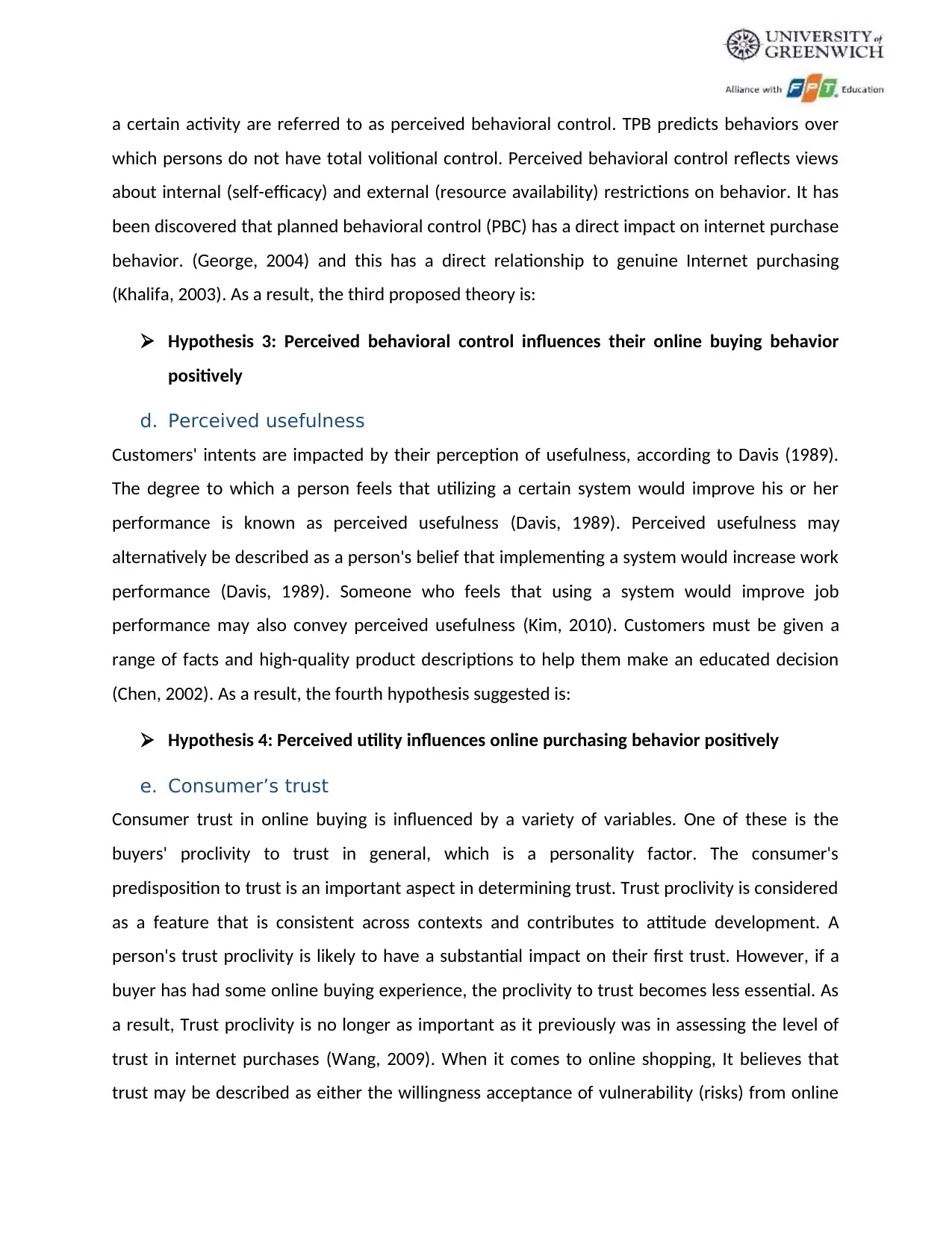
a certain activity are referred to as perceived behavioral control. TPB predicts behaviors over
which persons do not have total volitional control. Perceived behavioral control reflects views
about internal (self-efficacy) and external (resource availability) restrictions on behavior. It has
been discovered that planned behavioral control (PBC) has a direct impact on internet purchase
behavior. (George, 2004) and this has a direct relationship to genuine Internet purchasing
(Khalifa, 2003). As a result, the third proposed theory is:
Hypothesis 3: Perceived behavioral control influences their online buying behavior
positively
d. Perceived usefulness
Customers' intents are impacted by their perception of usefulness, according to Davis (1989).
The degree to which a person feels that utilizing a certain system would improve his or her
performance is known as perceived usefulness (Davis, 1989). Perceived usefulness may
alternatively be described as a person's belief that implementing a system would increase work
performance (Davis, 1989). Someone who feels that using a system would improve job
performance may also convey perceived usefulness (Kim, 2010). Customers must be given a
range of facts and high-quality product descriptions to help them make an educated decision
(Chen, 2002). As a result, the fourth hypothesis suggested is:
Hypothesis 4: Perceived utility influences online purchasing behavior positively
e. Consumer’s trust
Consumer trust in online buying is influenced by a variety of variables. One of these is the
buyers' proclivity to trust in general, which is a personality factor. The consumer's
predisposition to trust is an important aspect in determining trust. Trust proclivity is considered
as a feature that is consistent across contexts and contributes to attitude development. A
person's trust proclivity is likely to have a substantial impact on their first trust. However, if a
buyer has had some online buying experience, the proclivity to trust becomes less essential. As
a result, Trust proclivity is no longer as important as it previously was in assessing the level of
trust in internet purchases (Wang, 2009). When it comes to online shopping, It believes that
trust may be described as either the willingness acceptance of vulnerability (risks) from online
which persons do not have total volitional control. Perceived behavioral control reflects views
about internal (self-efficacy) and external (resource availability) restrictions on behavior. It has
been discovered that planned behavioral control (PBC) has a direct impact on internet purchase
behavior. (George, 2004) and this has a direct relationship to genuine Internet purchasing
(Khalifa, 2003). As a result, the third proposed theory is:
Hypothesis 3: Perceived behavioral control influences their online buying behavior
positively
d. Perceived usefulness
Customers' intents are impacted by their perception of usefulness, according to Davis (1989).
The degree to which a person feels that utilizing a certain system would improve his or her
performance is known as perceived usefulness (Davis, 1989). Perceived usefulness may
alternatively be described as a person's belief that implementing a system would increase work
performance (Davis, 1989). Someone who feels that using a system would improve job
performance may also convey perceived usefulness (Kim, 2010). Customers must be given a
range of facts and high-quality product descriptions to help them make an educated decision
(Chen, 2002). As a result, the fourth hypothesis suggested is:
Hypothesis 4: Perceived utility influences online purchasing behavior positively
e. Consumer’s trust
Consumer trust in online buying is influenced by a variety of variables. One of these is the
buyers' proclivity to trust in general, which is a personality factor. The consumer's
predisposition to trust is an important aspect in determining trust. Trust proclivity is considered
as a feature that is consistent across contexts and contributes to attitude development. A
person's trust proclivity is likely to have a substantial impact on their first trust. However, if a
buyer has had some online buying experience, the proclivity to trust becomes less essential. As
a result, Trust proclivity is no longer as important as it previously was in assessing the level of
trust in internet purchases (Wang, 2009). When it comes to online shopping, It believes that
trust may be described as either the willingness acceptance of vulnerability (risks) from online
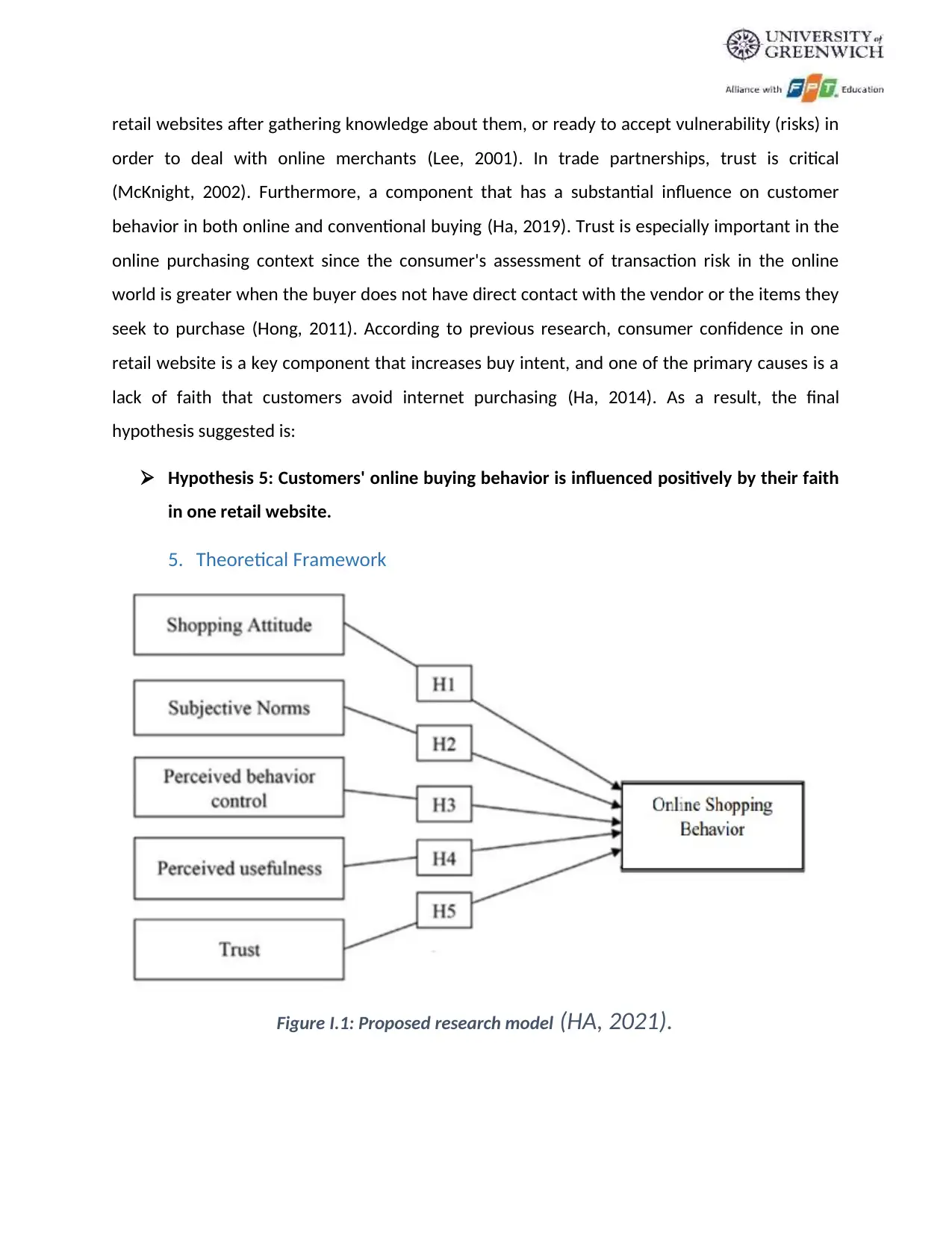
retail websites after gathering knowledge about them, or ready to accept vulnerability (risks) in
order to deal with online merchants (Lee, 2001). In trade partnerships, trust is critical
(McKnight, 2002). Furthermore, a component that has a substantial influence on customer
behavior in both online and conventional buying (Ha, 2019). Trust is especially important in the
online purchasing context since the consumer's assessment of transaction risk in the online
world is greater when the buyer does not have direct contact with the vendor or the items they
seek to purchase (Hong, 2011). According to previous research, consumer confidence in one
retail website is a key component that increases buy intent, and one of the primary causes is a
lack of faith that customers avoid internet purchasing (Ha, 2014). As a result, the final
hypothesis suggested is:
Hypothesis 5: Customers' online buying behavior is influenced positively by their faith
in one retail website.
5. Theoretical Framework
Figure I.1: Proposed research model (HA, 2021).
order to deal with online merchants (Lee, 2001). In trade partnerships, trust is critical
(McKnight, 2002). Furthermore, a component that has a substantial influence on customer
behavior in both online and conventional buying (Ha, 2019). Trust is especially important in the
online purchasing context since the consumer's assessment of transaction risk in the online
world is greater when the buyer does not have direct contact with the vendor or the items they
seek to purchase (Hong, 2011). According to previous research, consumer confidence in one
retail website is a key component that increases buy intent, and one of the primary causes is a
lack of faith that customers avoid internet purchasing (Ha, 2014). As a result, the final
hypothesis suggested is:
Hypothesis 5: Customers' online buying behavior is influenced positively by their faith
in one retail website.
5. Theoretical Framework
Figure I.1: Proposed research model (HA, 2021).
⊘ This is a preview!⊘
Do you want full access?
Subscribe today to unlock all pages.

Trusted by 1+ million students worldwide
1 out of 34
Related Documents
Your All-in-One AI-Powered Toolkit for Academic Success.
+13062052269
info@desklib.com
Available 24*7 on WhatsApp / Email
![[object Object]](/_next/static/media/star-bottom.7253800d.svg)
Unlock your academic potential
Copyright © 2020–2025 A2Z Services. All Rights Reserved. Developed and managed by ZUCOL.





